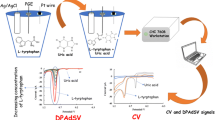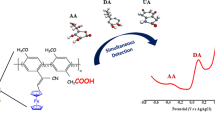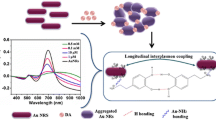Abstract
This work presents a novel electrochemical approach for detecting tryptophan through its interaction with copper nitroprusside, which is synthesized using a simple chemical co-precipitation method. The utilization of the reduction reaction inherent to copper nitroprusside effectively exhibits high selectivity against common interferences present in urine, such as melatonin, lactate, cytosine, cytidine, urea, ascorbic acid, creatine, creatinine, tyrosine, glycine, alanine, arginine, and lysine. The method demonstrates two linear ranges: 0.0–0.15 mmol/L and 0.15–2.0 mmol/L with the sensitivities of 119.7 ± 0.2 µA/(mmol/L) and 9.9 ± 0.4 µA/(mmol/L), respectively. The limit of detection (3SB/m) was determined to be 5.5 µmol/L. Application of the sensor in synthetic urine yielded the recovery of 103% ± 5%.









Similar content being viewed by others
Data availability
The authors declare that the data supporting the findings of this study are available within the paper. Should any raw data files be needed in another format they are available from the corresponding author upon reasonable request.
References
Mullaliu A, Sougrati M-T, Louvain N, Aquilanti G, Doublet M-L, Stievano L, Giorgetti M. The electrochemical activity of the nitrosyl ligand in copper nitroprusside: a new possible redox mechanism for lithium battery electrode materials? Electrochim Acta. 2017;257:364–71.
Balmaseda J, Reguera E, Gomez A, Roque J, Vazquez C, Autie M. On the microporous nature of transition metal nitroprussides. J Phys Chem B. 2003;107(41):11360–9.
Gómez A, Rodríguez-Hernández J, Reguera E. Unique coordination in metal nitroprussides: the structure of Cu[Fe(CN)5NO]⋅2H2O and Cu[Fe(CN)5NO]. J Chem Crystallogr. 2004;34:893–903.
Mullaliu A, Aquilanti G, Plaisier JR, Giorgetti M. Cross-investigation on copper nitroprusside: combining XRD and XAS for in-depth structural insights. Condensed Matter. 2021;6(3):27.
Carapuça HM, Filipe OM, Simão JE, Fogg AG. Electrochemical studies of nitroprusside in the presence of copper (II): formation of Cu (I) reduced nitroprusside species. J Electroanal Chem. 2000;480(1–2):84–93.
Mullaliu A, Stievano L, Aquilanti G, Plaisier JR, Cristol S, Giorgetti M. The peculiar redox mechanism of copper nitroprusside disclosed by a multi-technique approach. Radiat Phys Chem. 2020;175: 108336.
Mullaliu A, Aquilanti G, Stievano L, Conti P, Plaisier JR, Cristol S, Giorgetti M. Beyond the oxygen redox strategy in designing cathode material for batteries: Dynamics of a prussian blue-like cathode revealed by operando X-ray diffraction and X-ray absorption fine structure and by a theoretical approach. J Phys Chem C. 2019;123(14):8588–98.
Reguera L, Balmaseda J, Krap C, Reguera E. Hydrogen storage in porous transition metals nitroprussides. J Phys Chem C. 2008;112(28):10490–501.
Roque-Malherbe R, Lozano C, Polanco R, Marquez F, Lugo F, Hernandez-Maldonado A, Primera-Pedrozo J. Study of carbon dioxide adsorption on a Cu-nitroprusside polymorph. J Solid State Chem. 2011;184(5):1236–44.
Rahut S, Patra SK, Basu JK. Surfactant assisted self assembly of novel ultrathin Cu [Fe (CN)5NO] nanosheets for enhanced electrocatalytic oxygen evolution: effect of nanosheet thickness. Electrochim Acta. 2018;265:202–8.
Carapuca HM, Simao JE, Fogg AG. Electrochemistry of the nitroprusside ion. From mechanistic studies to electrochemical analysis. Analyst. 1996;121(12):1801–4.
Jankhunthod S, Moonla C, Watwiangkham A, Suthirakun S, Siritanon T, Wannapaiboon S, Ngamchuea K. Understanding electrochemical and structural properties of copper hexacyanoferrate: application in hydrogen peroxide analysis. Electrochim Acta. 2021;394: 139147.
Wright AM, Hayton TW. Recent developments in late metal nitrosyl chemistry. Comments Inorg Chem. 2012;33(5–6):207–48.
Kałużna-Czaplińska J, Gątarek P, Chirumbolo S, Chartrand MS, Bjørklund G. How important is tryptophan in human health? Crit Rev Food Sci Nutr. 2019;59(1):72–88.
Comai S, Bertazzo A, Brughera M, Crotti S. Tryptophan in health and disease. Adv Clin Chem. 2020;95:165–218.
Liu X-H, Zhai X-Y. Role of tryptophan metabolism in cancers and therapeutic implications. Biochimie. 2021;182:131–9.
Widner B, Leblhuber F, Walli J, Tilz G, Demel U, Fuchs D. Tryptophan degradation and immune activation in Alzheimer’s disease. J Neural Transm. 2000;107:343–53.
Lovelace MD, Varney B, Sundaram G, Lennon MJ, Lim CK, Jacobs K, Guillemin GJ, Brew BJ. Recent evidence for an expanded role of the kynurenine pathway of tryptophan metabolism in neurological diseases. Neuropharmacology. 2017;112:373–88.
Fernstrom JD. A perspective on the safety of supplemental tryptophan based on its metabolic fates. J Nutr. 2016;146(12):2601S-2608S.
Oketch-Rabah HA, Roe AL, Gurley BJ, Griffiths JC, Giancaspro GI. The importance of quality specifications in safety assessments of amino acids: the cases of L-tryptophan and L-citrulline. J Nutr. 2016;146(12):2643S-2651S.
Nasimi H, Madsen JS, Zedan AH, Malmendal A, Osther PJS, Alatraktchi FAA. Electrochemical sensors for screening of tyrosine and tryptophan as biomarkers for diseases: a narrative review. Microchem J. 2023;5:108737.
Rattanaumpa T, Maensiri S, Ngamchuea K. Microporous carbon in the selective electro-oxidation of molecular biomarkers: uric acid, ascorbic acid, and dopamine. RSC Adv. 2022;12(29):18709–21.
Ngamchuea K, Lin C, Batchelor-McAuley C, Compton RG. Supported microwires for electroanalysis: sensitive amperometric detection of reduced glutathione. Anal Chem. 2017;89(6):3780–6.
Ravel B, Newville M. Athena, artemis, hephaestus: data analysis for X-ray absorption spectroscopy using IFEFFIT. J Synchrotron Radiat. 2005;12(4):537–41.
Jiang G, Wang J, Yang Y, Zhang G, Liu Y, Lin H, Zhang G, Li Y, Fan X. Fluorescent turn-on sensing of bacterial lipopolysaccharide in artificial urine sample with sensitivity down to nanomolar by tetraphenylethylene based aggregation induced emission molecule. Biosens Bioelectron. 2016;85:62–7.
Asakura D, Okubo M, Zhou H, Amemiya K, Okada K, Glans P-A, Jenkins CA, Arenholz E, Guo J. Anisotropic charge-transfer effects in the asymmetric Fe(CN)5NO octahedron of sodium nitroprusside: a soft X-ray absorption spectroscopy study. Phys Chem Chem Phys. 2014;16(15):7031–6.
Giorgetti M, Berrettoni M, Filipponi A, Kulesza PJ, Marassi R. Evidence of four-body contributions in the EXAFS spectrum of Na2Co[Fe(CN)6]. Chem Phys Lett. 1997;275(1–2):108–12.
Carapuça HM, Simao JE, Fogg AG. Comproportionation and disproportionation reactions in the electrochemical reduction of nitroprusside at a hanging mercury drop electrode in acidic solution. J Electroanal Chem. 1998;455(1–2):93–105.
Moonla C, Jankhunthod S, Ngamchuea K. Copper hexacyanoferrate as a novel electrode material in electrochemical detection of cumene hydroperoxide. J Electrochem Soc. 2021;168(11): 116507.
Kadhim M, Gamaj MI. Estimation of the diffusion coefficient and hydrodynamic radius (stokes radius) for inorganic ions in solution depending on molar conductivity as electro-analytical technique-a review. J Chem Rev. 2020;2(3):182–8.
Cano A, Rodríguez-Hernández J, Shchukarev A, Reguera E. Intercalation of pyrazine in layered copper nitroprusside: synthesis, crystal structure and XPS study. J Solid State Chem. 2019;273:1–10.
Dalirirad S, Steckl AJ. Lateral flow assay using aptamer-based sensing for on-site detection of dopamine in urine. Anal Biochem. 2020;596: 113637.
Abellán-Llobregat A, González-Gaitán C, Vidal L, Canals A, Morallon E. Portable electrochemical sensor based on 4-aminobenzoic acid-functionalized herringbone carbon nanotubes for the determination of ascorbic acid and uric acid in human fluids. Biosens Bioelectron. 2018;109:123–31.
Abellán-Llobregat A, Vidal L, Rodríguez-Amaro R, Berenguer-Murcia Á, Canals A, Morallon E. Au-IDA microelectrodes modified with Au-doped graphene oxide for the simultaneous determination of uric acid and ascorbic acid in urine samples. Electrochim Acta. 2017;227:275–84.
Khan MI, Zhang Q, Wang Y, Saud S, Liu W, Liu S, Kong H, Wang C, Uzzaman A, Xiao H. Portable electrophoresis titration chip model for sensing of uric acid in urine and blood by moving reaction boundary. Sens Actuators, B Chem. 2019;286:9–15.
Kałuzna-Czaplinska J, Michalska M, Rynkowski J. Determination of tryptophan in urine of autistic and healthy children by gas chromatography/mass spectrometry. Med Sci Monit. 2010;16(10):488–92.
Mao S, Li W, Long Y, Tu Y, Deng A. Sensitive electrochemical sensor of tryptophan based on Ag@ C core–shell nanocomposite modified glassy carbon electrode. Anal Chim Acta. 2012;738:35–40.
Xia X, Zheng Z, Zhang Y, Zhao X, Wang C. Synthesis of Ag-MoS2/chitosan nanocomposite and its application for catalytic oxidation of tryptophan. Sens Actuators, B Chem. 2014;192:42–50.
Tığ GA. Development of electrochemical sensor for detection of ascorbic acid, dopamine, uric acid and l-tryptophan based on Ag nanoparticles and poly (l-arginine)-graphene oxide composite. J Electroanal Chem. 2017;807:19–28.
Kooshki M, Abdollahi H, Bozorgzadeh S, Haghighi B. Second-order data obtained from differential pulse voltammetry: determination of tryptophan at a gold nanoparticles decorated multiwalled carbon nanotube modified glassy carbon electrode. Electrochim Acta. 2011;56(24):8618–24.
Khan MZH, Liu X, Tang Y, Zhu J, Hu W, Liu X. A glassy carbon electrode modified with a composite consisting of gold nanoparticle, reduced graphene oxide and poly (L-arginine) for simultaneous voltammetric determination of dopamine, serotonin and L-tryptophan. Microchim Acta. 2018;185:1–10.
Rezaei F, Ashraf N, Zohuri GH. A smart electrochemical sensor based upon hydrophilic core–shell molecularly imprinted polymer for determination of L-tryptophan. Microchem J. 2023;185: 108260.
Jin G-P, Lin X-Q. The electrochemical behavior and amperometric determination of tyrosine and tryptophan at a glassy carbon electrode modified with butyrylcholine. Electrochem Commun. 2004;6(5):454–60.
Wang C, Zou X, Zhao X, Wang Q, Tan J, Yuan R. Cu-nanoparticles incorporated overoxidized-poly (3-amino-5-mercapto-1, 2, 4-triazole) film modified electrode for the simultaneous determination of ascorbic acid, dopamine, uric acid and tryptophan. J Electroanal Chem. 2015;741:36–41.
He Q, Tian Y, Wu Y, Liu J, Li G, Deng P, Chen D. Electrochemical sensor for rapid and sensitive detection of tryptophan by a Cu2O nanoparticles-coated reduced graphene oxide nanocomposite. Biomolecules. 2019;9(5):176.
Liu J, Dong S, He Q, Yang S, Xie M, Deng P, Xia Y, Li G. Facile preparation of Fe3O4/C nanocomposite and its application for cost-effective and sensitive detection of tryptophan. Biomolecules. 2019;9(6):245.
Li Y-J, Yang L-L, Ni L, Xiong J-M, He J-Y, Zhou L-D, Luo L, Zhang Q-H, Yuan C-S. Constructing electrochemical sensor using molecular-imprinted polysaccharide for rapid identification and determination of L-tryptophan in diet. Food Chem. 2023;425:136486.
Qian J, Yi Y, Zhang D, Zhu G. Electrochemical recognition of tryptophan enantiomers using a multi-walled carbon nanotube@ polydopamine composite loaded with copper (II). Microchim Acta. 2019;186:1–9.
Yang F, Xie Q, Zhang H, Yu S, Zhang X, Shen Y. Simultaneous determination of ascorbic acid, uric acid, tryptophan and adenine using carbon-supported NiCoO2 nanoparticles. Sens Actuators, B Chem. 2015;210:232–40.
Wang C, Xiong Z, Sun P, Wang R, Zhao X, Wang Q. Facile longitudinal unzipped multiwalled carbon nanotubes incorporated overoxidized poly (p-aminophenol) modified electrode for sensitive simultaneous determination of dopamine, uric acid and tryptophan. J Electroanal Chem. 2017;801:395–402.
Karabozhikova V, Tsakova V, Lete C, Marin M, Lupu S. Poly (3, 4-ethylenedioxythiophene)-modified electrodes for tryptophan voltammetric sensing. J Electroanal Chem. 2019;848: 113309.
Khoshnevisan K, Torabi F, Baharifar H, Sajjadi-Jazi SM, Afjeh MS, Faridbod F, Larijani B, Khorramizadeh MR. Determination of the biomarker L-tryptophan level in diabetic and normal human serum based on an electrochemical sensing method using reduced graphene oxide/gold nanoparticles/18-crown-6. Anal Bioanal Chem. 2020;412:3615–27.
Yang X, Niu X, Mo Z, Guo R, Liu N, Zhao P, Liu Z. Perylene-functionalized graphene sheets modified with chitosan for voltammetric discrimination of tryptophan enantiomers. Microchim Acta. 2019;186:1–12.
Zhou S, Deng Z, Wu Z, Xie M, Tian Y, Wu Y, Liu J, Li G, He Q. Ta2O5/rGO nanocomposite modified electrodes for detection of tryptophan through electrochemical route. Nanomaterials. 2019;9(6):811.
Acknowledgements
This research has received funding support from (i) Suranaree University of Technology (SUT) and (ii) the NSRF via the Program Management Unit for Human Resources & Institutional Development, Research and Innovation (PMU-B) (B13F660067). Ngamchuea K. acknowledges funding from (i) Suranaree University of Technology (SUT), (ii) Thailand Science Research and Innovation (TSRI), and (iii) National Science, Research and Innovation Fund (NSRF, NRIIS number 189603).
Author information
Authors and Affiliations
Corresponding author
Ethics declarations
Conflict of Interest
The authors declare no known competing financial interests or personal relationships that could have appeared to influence the work reported in this paper.
About this article
Cite this article
Sunon, P., Rattanaumpa, T., Phakhunthod, K. et al. Copper Nitroprusside-Based Electrochemical Sensor for Detection of Tryptophan. J. Anal. Test. 7, 405–415 (2023). https://doi.org/10.1007/s41664-023-00280-0
Received:
Accepted:
Published:
Issue Date:
DOI: https://doi.org/10.1007/s41664-023-00280-0




